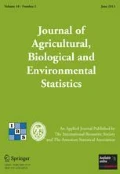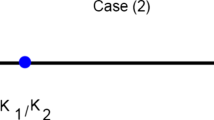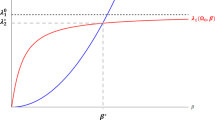Abstract
Landscape heterogeneity can often be represented as a series of discrete habitat or resource patches surrounded by a matrix of non-habitat. Understanding how animals move in such networks of patches is important for many theoretical and applied questions. The probability of going from one patch to another is affected in a non-trivial way by the characteristics and location of other patches in the network. Nearby patches can compete as possible destinations, and a particular patch can be shadowed by neighboring patches. We present a way to account for the effects of the spatial configuration of patches in models of space use where individuals alternate between spending time in a patch and moving to other patches in the network. The approach is based on the original derivation of Ovaskainen and Cornell (J Appl Probab 40:557–580, 2003) for a diffusion model that considered all possible ways in which an individual leaving a particular patch can eventually reach another patch before dying or leaving the patch network. By replacing the theoretical results of Ovaskainen and Cornell by other appropriate functions, we provide generality and thus make their approach useful in contexts where diffusion is not a good approximation of movement. Furthermore, we provide ways to estimate time spent in the non-habitat matrix when going from patch to patch and implement a method to incorporate the effect of the history of previous visits on future patch use. We present an MCMC way to fit these models to data and illustrate the approach with both simulated data and data from sheep moving among seasonally flooded meadows in northern Patagonia.Supplementary materials accompanying this paper appear online.







Similar content being viewed by others
References
Avgar, T., Baker, J. A., Brown, G. S., Hagens, J. S., Kittle, A. M., Mallon, E. E., McGreer, M. T., Mosser, A., Newmaster, S. G., Patterson, B. R., Reid, D. E. B., Rodgers, A. R., Shuter, J., Street, G. M., Thompson, I., Turetsky, M. J., Wiebe, P. A., and Fryxell, J. M. “Space-use behaviour of woodland caribou based on a cognitive movement model.” Journal of Animal Ecology, 84(4):1059–1070 (2015).
Bates, D. and Maechler, M. “Matrix: sparse and dense matrix classes and methods.” R package version 0.999375-43, URL http://cran.r-project.org/package=Matrix (2010).
Belisle, M. “Measuring landscape connectivity: The challenge of behavioral landscape ecology.” Ecology, 86(8):1988–1995 (2005).
Benton, T. G. and Bowler, D. E. “Dispersal in invertebrates: influences on individual decisions.” Dispersal ecology and evolution, 41–49 (2012).
Bivand, R. and Rundel, C. “rgeos: Interface to Geometry Engine-Open Source (GEOS). 2012.” URL http://CRAN.R-project.org/package=rgeos. R package version 0.3-14. (2012).
Borchers, D. L. and Efford, M. “Spatially explicit maximum likelihood methods for capture–recapture studies.” Biometrics, 64(2):377–385 (2008).
Boyer, D. and Walsh, P. D. “Modelling the mobility of living organisms in heterogeneous landscapes: does memory improve foraging success?” Philosophical Transactions of The Royal Society A-Mathematical Physical and Engineering Sciences, 368(1933):5645–5659 (2010).
Brooks, S., Gelman, A., Jones, G., and Meng, X.-L. Handbook of Markov Chain Monte Carlo. CRC press (2011).
Brownie, C., Hines, J., Nichols, J., Pollock, K., and Hestbeck, J. “Capture-recapture studies for multiple strata including non-Markovian transitions.” Biometrics, 1173–1187 (1993).
Cabrera, A. L. Regiones fitogeográficas argentinas. Enciclopedia Argentina de Agricultura y Jardinería (1976).
Calabrese, J. and Fagan, W. “A comparison-shopper’s guide to connectivity metrics.” Frontiers In Ecology and the Environment, 2(10):529–536 (2004).
Carlo, T. A., Aukema, J. E., and Morales, J. M. “Plant-frugivore interactions as spatially explicit networks: integrating frugivore foraging with fruiting plant spatial patterns.” In Dennis, A. J., Schupp, E. W., Green, R. J., and et al. (eds.), Seed dispersal: theory and its application in a changing world, 369–390. CABI (2007).
Chapuis, M.-P. and Estoup, A. “Microsatellite null alleles and estimation of population differentiation.” Molecular biology and evolution, 24(3):621–631 (2007).
Coulon, A., Cosson, J., Angibault, J., Cargnelutti, B., Galan, M., Morellet, N., Petit, E., Aulagnier, S., and Hewison, A. “Landscape connectivity influences gene flow in a roe deer population inhabiting a fragmented landscape: an individual–based approach.” Molecular ecology, 13(9):2841–2850 (2004).
Dalziel, B. D., Morales, J. M., and Fryxell, J. M. “Fitting probability distributions to animal movement trajectories: Using artificial neural networks to link distance, resources, and memory.” American Naturalist, 172(2):248–258 (2008).
diVirgilio, A. and Morales, J. M. “Towards evenly distributed grazing patterns: Including social context in sheep management strategies.” PeerJ, 4:e2152 (2016).
Fagan, W., Lewis, M., Auger-Méthé, M., Avgar, T., Benhamou, S., Breed, G., LaDage, L., Schlägel, U., Tang, W., Papastamatiou, Y., Forester, J., and Mueller, T. “Spatial memory and animal movement.” Ecology Letters, 16:1316–1329 (2013).
Fahrig, L. “Effect of habitat fragmentation on the extinction threshold: a synthesis.” Ecological applications, 12(2):346–353 (2002).
Fasiolo, M., Pya, N., and Wood, S. N. “A Comparison of Inferential Methods for Highly Nonlinear State Space Models in Ecology and Epidemiology.” Statistical Science, 31(1):96–118 (2016).
Forman, R. T. and Godron, M. “Patches and structural components for a landscape ecology.” BioScience, 31(10):733–740 (1981).
Fortuna, M. A., García, C., Guimarães Jr, P. R., and Bascompte, J. “Spatial mating networks in insect-pollinated plants.” Ecology letters, 11(5):490–498 (2008).
Fuller, A. K., Sutherland, C. S., Royle, J. A., and Hare, M. P. “Estimating population density and connectivity of American mink using spatial capture–recapture.” Ecological Applications, 26(4):1125–1135 (2016). http://dx.doi.org/10.1890/15-0315
Gelman, A. and Rubin, D. B. “Inference from iterative simulation using multiple sequences.” Statistical science, 457–472 (1992).
Gómez, J. M. and Perfectti, F. “Fitness consequences of centrality in mutualistic individual-based networks.” Proceedings of the Royal Society of London B: Biological Sciences, 279(1734):1754–1760 (2012). http://rspb.royalsocietypublishing.org/content/279/1734/1754
Grimm, V. and Berger, U. “Structural realism, emergence, and predictions in next-generation ecological modelling: Synthesis from a special issue.” Ecological Modelling, 326(SI):177–187 (2016).
Hanski, I. “Metapopulation dynamics.” Nature, 396(6706):41–49 (1998).
——. “Habitat connectivity, habitat continuity, and metapopulations in dynamic landscapes.” Oikos, 209–219 (1999a).
——. Metapopulation ecology. Oxford University Press (1999b).
Hanski, I. and Ovaskainen, O. “The metapopulation capacity of a fragmented landscape.” Nature, 404(6779):755–758 (2000).
Hanski, I., Saastamoinen, M., and Ovaskainen, O. “Dispersal-related life-history trade-offs in a butterfly metapopulation.” Journal of Animal Ecology, 75(1):91–100 (2006).
Hooten, M., Johnson, D., McClintock, B., and Morales, J. Animal Movement: Statistical Models for Telemetry Data. Chapman & Hall/CRC Boca Raton, Florida, USA (2017).
Kays, R., Crofoot, M. C., Jetz, W., and Wikelski, M. “Terrestrial animal tracking as an eye on life and planet.” Science, 348(6240):aaa2478 (2015).
Koen, E. L., Bowman, J., Sadowski, C., and Walpole, A. A. “Landscape connectivity for wildlife: development and validation of multispecies linkage maps.” Methods in Ecology and Evolution, 5(7):626–633 (2014).
LaPoint, S., Gallery, P., Wikelski, M., and Kays, R. “Animal behavior, cost-based corridor models, and real corridors.” Landscape Ecology, 28(8):1615–1630 (2013).
León, R. J., Bran, D., Collantes, M., Paruelo, J. M., and Soriano, A. “Grandes unidades de vegetación de la Patagonia extra andina.” Ecología Austral, 8(2):125–144 (1998).
Matthiopoulos, J., Fieberg, J., Aarts, G., Beyer, H. L., Morales, J. M., and Haydon, D. T. “Establishing the link between habitat selection and animal population dynamics.” Ecological Monographs, 85(3):413–436 (2015).
McClintock, B., King, R., Thomas, L., Matthiopoulos, J., McConnell, B., and Morales, J. “A general discrete-time modeling framework for animal movement using multistate random walks.” Ecological Monographs, 82:335–349 (2012).
McRae, B. H. and Beier, P. “Circuit theory predicts gene flow in plant and animal populations.” Proceedings of the National Academy of Sciences, 104(50):19885–19890 (2007).
Merkle, J., Fortin, D., and Morales, J. “A memory-based foraging tactic reveals an adaptive mechanism for restricted space use.” Ecology letters, 17:924–931 (2014).
Montoya, D., Rogers, L., and Memmott, J. “Emerging perspectives in the restoration of biodiversity-based ecosystem services.” Trends in ecology & evolution, 27(12):666–672 (2012).
Morales, J. M. and Carlo, T. A. “The effects of plant distribution and frugivore density on the scale and shape of dispersal kernels.” Ecology, 87:1489–1496 (2006).
Morales, J. M., García, D., Martínez, D., Rodriguez-Pérez, J., and Herrera, J. M. “Frugivore behavioural details matter for seed dispersal: a multi-species model for Cantabrian thrushes and trees.” PLoS One, 8(6):e65216 (2013).
Morales, J. M., Moorcroft, P., Matthiopoulos, J., Frair, J., Kie, J., Powell, R., Merrill, E., and Haydon, D. “Building the bridge between animal movement and population dynamics.” Philosophical Transactions of the Royal Society of London B: Biological Sciences, 365:2289–2301 (2010).
Ovaskainen, O. “Analytical and numerical tools for diffusion-based movement models.” Theoretical Population Biology, 73(2):198–211 (2008).
Ovaskainen, O. and Cornell, S. J. “Biased movement at a boundary and conditional occupancy times for diffusion processes.” Journal of Applied Probability, 40(3):557–580 (2003).
Ovaskainen, O. and Hanski, I. “Metapopulation Dynamics in Highly Fragmented Landscapes.” In Hanski, I. and Gaggiotti, O. E. (eds.), Ecology, Genetics and Evolution of Metapopulations, 73 – 103. Burlington: Academic Press (2004). www.sciencedirect.com/science/article/pii/B9780123234483500064
Palmer, S. C., Coulon, A., and Travis, J. M. “Introducing a ‘stochastic movement simulator’ for estimating habitat connectivity.” Methods in Ecology and Evolution, 2(3):258–268 (2011).
Pebesma, E. J. and Bivand, R. S. “Classes and methods for spatial data in R.” R News, 5(2):9–13 (2005). https://CRAN.R-project.org/doc/Rnews/
Plummer, M., Best, N., Cowles, K., and Vines, K. “CODA: Convergence diagnosis and output analysis for MCMC.” R news, 6(1):7–11 (2006).
Pullinger, M. G. and Johnson, C. J. “Maintaining or restoring connectivity of modified landscapes: evaluating the least-cost path model with multiple sources of ecological information.” Landscape Ecology, 25(10):1547–1560 (2010).
Rayfield, B., Fortin, M.-J., and Fall, A. “Connectivity for conservation: a framework to classify network measures.” Ecology, 92(4):847–858 (2011).
Revilla, E. and Wiegand, T. “Individual movement behavior, matrix heterogeneity, and the dynamics of spatially structured populations.” Proceedings of the National Academy of Sciences, 105(49):19120–19125 (2008).
Riotte-Lambert, L., Benhamou, S., and Chamaille-Jammes, S. “How Memory-Based Movement Leads to Nonterritorial Spatial Segregation.” American Naturalist, 185(4):E103–E116 (2015).
Royle, J. A. and Young, K. V. “A hierarchical model for spatial capture–recapture data.” Ecology, 89(8):2281–2289 (2008).
Saura, S. and Pascual-Hortal, L. “A new habitat availability index to integrate connectivity in landscape conservation planning: Comparison with existing indices and application to a case study.” Landscape and Urban Planning, 83(2-3):91–103 (2007).
Schwarz, C. J., Schweigert, J. F., and Arnason, A. N. “Estimating migration rates using tag-recovery data.” Biometrics, 177–193 (1993).
Sork, V. L., Nason, J., Campbell, D. R., and Fernandez, J. F. “Landscape approaches to historical and contemporary gene flow in plants.” Trends in Ecology & Evolution, 14(6):219–224 (1999).
Urban, D. and Keitt, T. “Landscape connectivity: a graph-theoretic perspective.” Ecology, 82(5):1205–1218 (2001).
van der Vaart, E., Beaumont, M. A., Johnston, A. S. A., and Sibly, R. M. “Calibration and evaluation of individual-based models using Approximate Bayesian Computation.” Ecological Modelling, 312:182–190 (2015).
Waples, R. S. and Gaggiotti, O. “What is a population? An empirical evaluation of some genetic methods for identifying the number of gene pools and their degree of connectivity.” Molecular ecology, 15(6):1419–1439 (2006).
Zheng, C., Pennanen, J., and Ovaskainen, O. “Modelling dispersal with diffusion and habitat selection: analytical results for highly fragmented landscapes.” Ecological modelling, 220(12):1495–1505 (2009).
Acknowledgements
We thank the editor and two anonymous reviewers for thorough and useful comments on the manuscript. JMM was supported by CONICET and by PIP 112 201101 00058. MMD was granted by a Spanish “Ramón y Cajal” contract RYC-2014-16263 and financially supported by the Spanish Ministry of Economy and Competitiveness (#CGL2016-79764-P). OO was supported by funding from the Academy of Finland (Grant No. 250444) and the Research Council of Norway (CoE Grant No. 223257).
Author information
Authors and Affiliations
Corresponding author
Electronic supplementary material
Below is the link to the electronic supplementary material.
Rights and permissions
About this article
Cite this article
Morales, J.M., di Virgilio, A., del Mar Delgado, M. et al. A General Approach to Model Movement in (Highly) Fragmented Patch Networks. JABES 22, 393–412 (2017). https://doi.org/10.1007/s13253-017-0298-1
Received:
Accepted:
Published:
Issue Date:
DOI: https://doi.org/10.1007/s13253-017-0298-1




